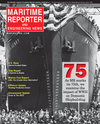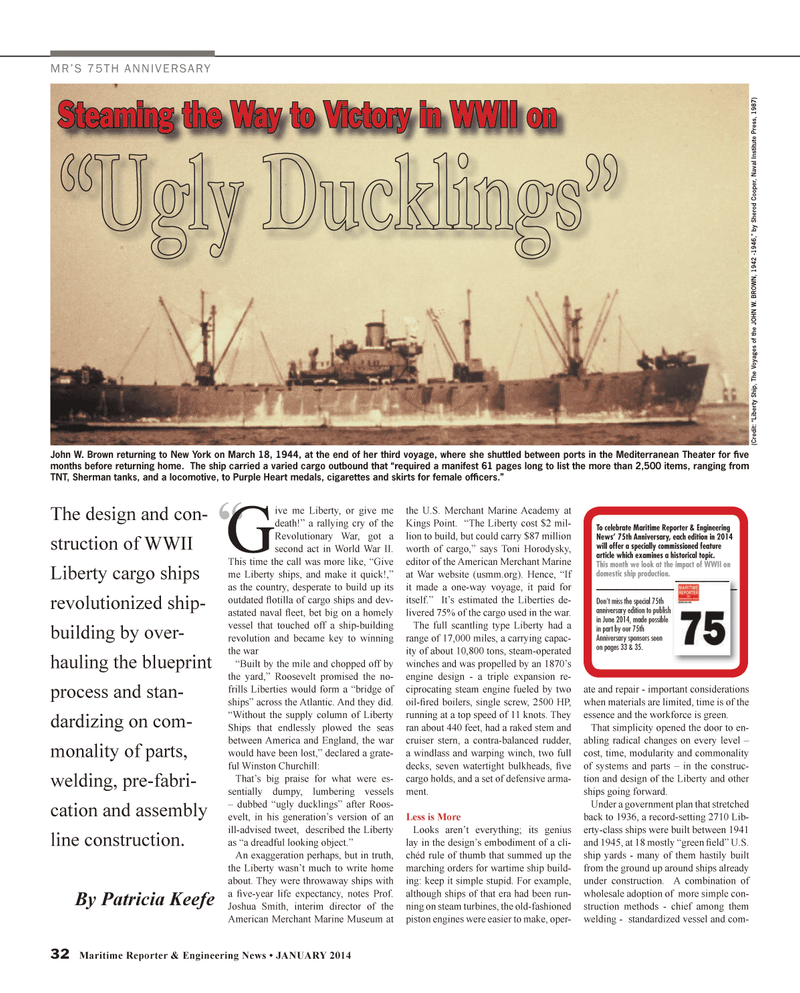
Page 32: of Maritime Reporter Magazine (January 2014)
Ship Repair & Conversion Edition
Read this page in Pdf, Flash or Html5 edition of January 2014 Maritime Reporter Magazine
32 Maritime Reporter & Engineering News • JANUARY 2014 “
G ive me Liberty, or give me death!” a rallying cry of the
Revolutionary War, got a second act in World War II.
This time the call was more like, “Give me Liberty ships, and make it quick!,” as the country, desperate to build up its outdated fl otilla of cargo ships and dev- astated naval fl eet, bet big on a homely vessel that touched off a ship-building revolution and became key to winning the war “Built by the mile and chopped off by the yard,” Roosevelt promised the no- frills Liberties would form a “bridge of ships” across the Atlantic. And they did. “Without the supply column of Liberty
Ships that endlessly plowed the seas between America and England, the war would have been lost,” declared a grate- ful Winston Churchill:
That’s big praise for what were es- sentially dumpy, lumbering vessels – dubbed “ugly ducklings” after Roos- evelt, in his generation’s version of an ill-advised tweet, described the Liberty as “a dreadful looking object.”
An exaggeration perhaps, but in truth, the Liberty wasn’t much to write home about. They were throwaway ships with a fi ve-year life expectancy, notes Prof.
Joshua Smith, interim director of the
American Merchant Marine Museum at the U.S. Merchant Marine Academy at
Kings Point. “The Liberty cost $2 mil- lion to build, but could carry $87 million worth of cargo,” says Toni Horodysky, editor of the American Merchant Marine at War website (usmm.org). Hence, “If it made a one-way voyage, it paid for itself.” It’s estimated the Liberties de- livered 75% of the cargo used in the war.
The full scantling type Liberty had a range of 17,000 miles, a carrying capac- ity of about 10,800 tons, steam-operated winches and was propelled by an 1870’s engine design - a triple expansion re- ciprocating steam engine fueled by two oil-fi red boilers, single screw, 2500 HP, running at a top speed of 11 knots. They ran about 440 feet, had a raked stem and cruiser stern, a contra-balanced rudder, a windlass and warping winch, two full decks, seven watertight bulkheads, fi ve cargo holds, and a set of defensive arma- ment.
Less is More
Looks aren’t everything; its genius lay in the design’s embodiment of a cli- chéd rule of thumb that summed up the marching orders for wartime ship build- ing: keep it simple stupid. For example, although ships of that era had been run- ning on steam turbines, the old-fashioned piston engines were easier to make, oper- ate and repair - important considerations when materials are limited, time is of the essence and the workforce is green.
That simplicity opened the door to en- abling radical changes on every level – cost, time, modularity and commonality of systems and parts – in the construc- tion and design of the Liberty and other ships going forward.
Under a government plan that stretched back to 1936, a record-setting 2710 Lib- erty-class ships were built between 1941 and 1945, at 18 mostly “green fi eld” U.S. ship yards - many of them hastily built from the ground up around ships already under construction. A combination of wholesale adoption of more simple con- struction methods - chief among them welding - standardized vessel and com-
MR’S 75TH ANNIVERSARY
Steaming the Way to Victory in WWII on
To celebrate Maritime Reporter & Engineering
News’ 75th Anniversary, each edition in 2014 will offer a specially commissioned feature article which examines a historical topic.
This month we look at the impact of WWII on domestic ship production.
Don’t miss the special 75th anniversary edition to publish in June 2014, made possible in part by our 75th
Anniversary sponsors seen on pages 33 & 35.
The design and con- struction of WWII
Liberty cargo ships revolutionized ship- building by over- hauling the blueprint process and stan- dardizing on com- monality of parts, welding, pre-fabri- cation and assembly line construction.
By Patricia Keefe
John W. Brown returning to New York on March 18, 1944, at the end of her third voyage, where she shuttled between ports in the Mediterranean Theater for fi ve months before returning home. The ship carried a varied cargo outbound that “required a manifest 61 pages long to list the more than 2,500 items, ranging from
TNT, Sherman tanks, and a locomotive, to Purple Heart medals, cigarettes and skirts for female offi cers.” (Cr edit: “Liber ty Ship, The V oyages of the JOHN W . BROWN, 1942 -1946,” by Sher od Cooper , Naval Institute Pr ess, 1987)
MR #1 (32-41).indd 32 1/7/2014 10:50:06 AM

 31
31

 33
33
